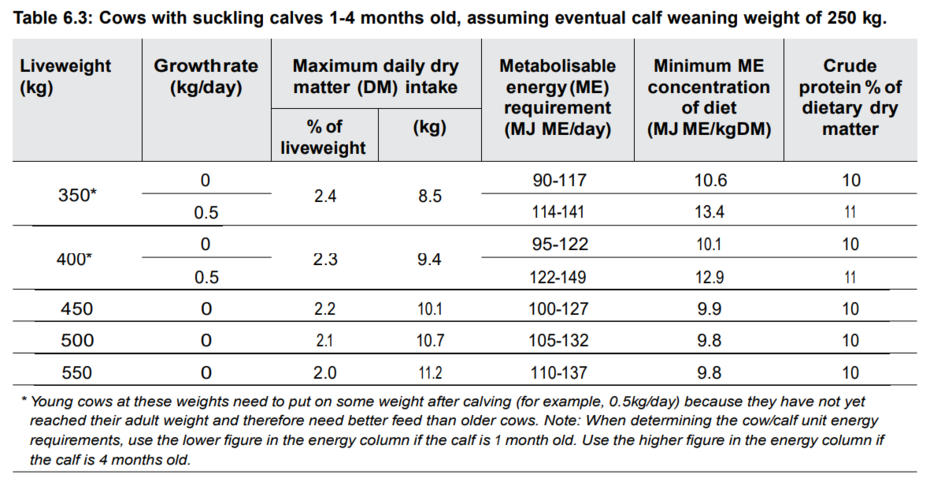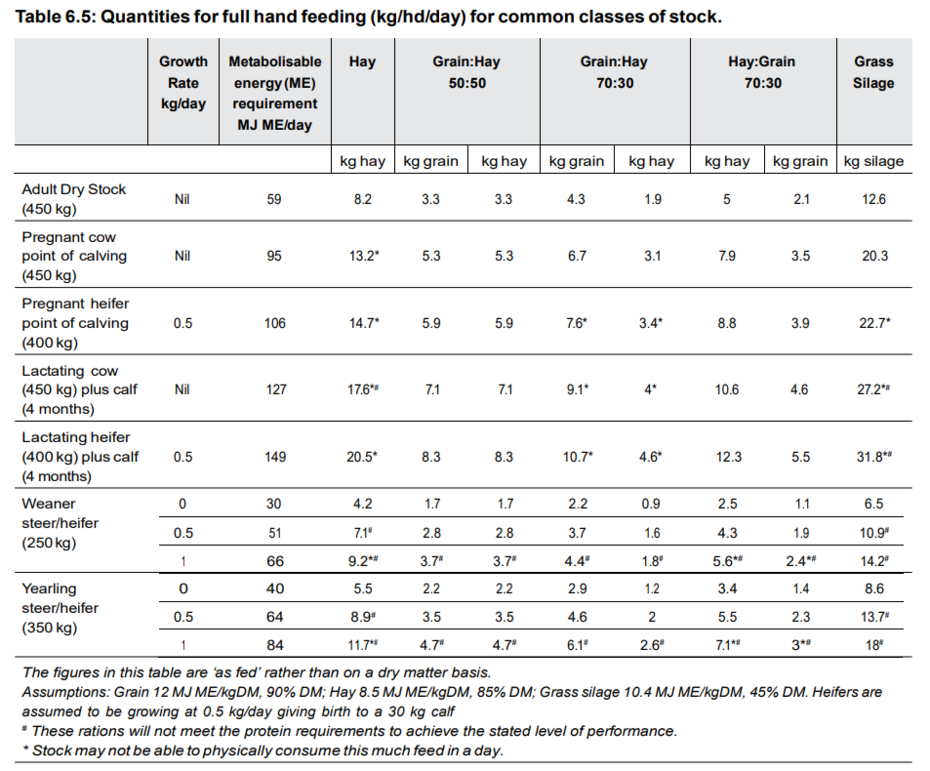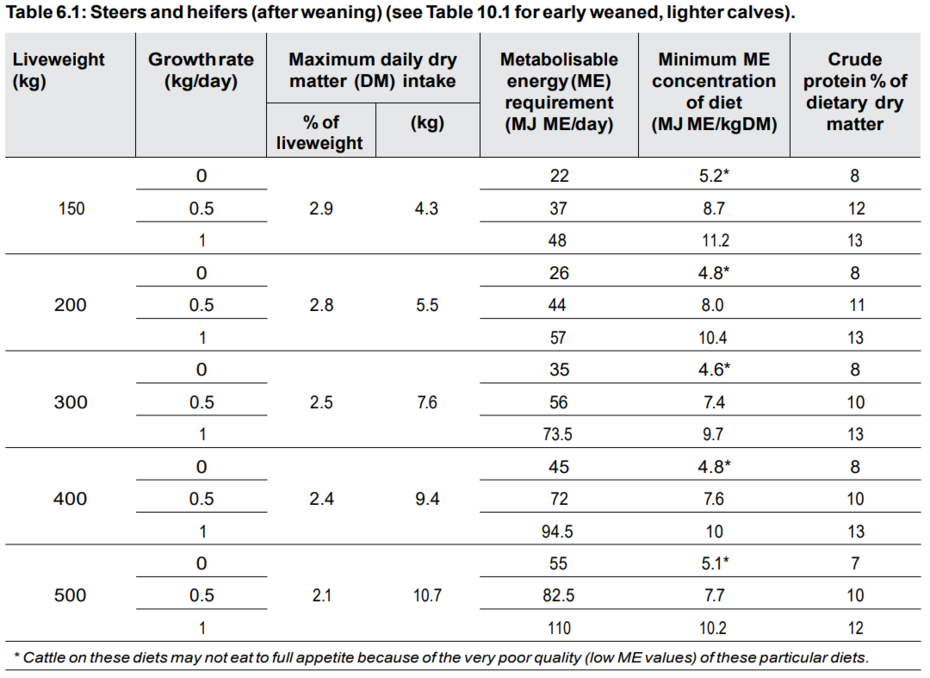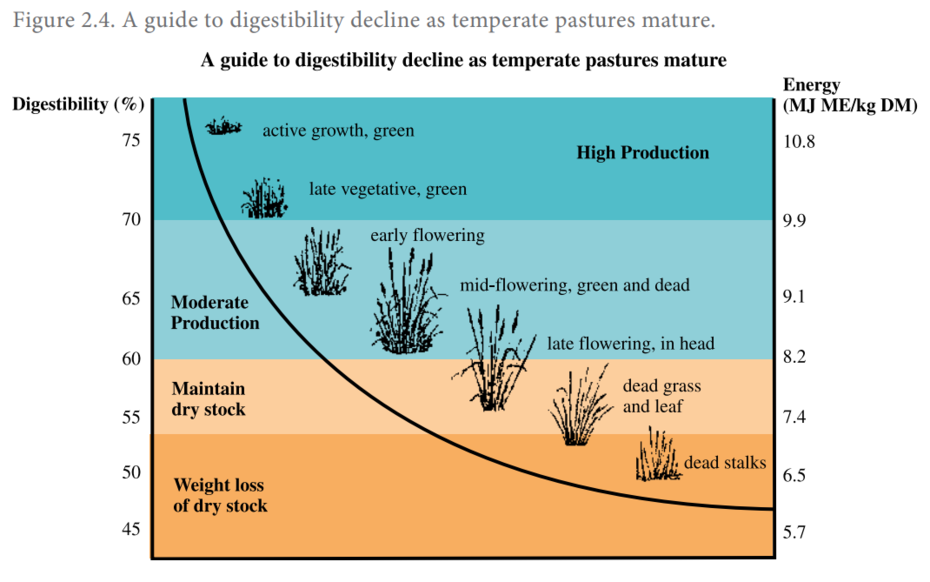Posted May 12, 2022
The goal of weaning is to produce a good calf that performs to its genetic potential and to keep the breeding herd in good condition, in order to return cows to estrus as soon as possible.
This can become a challenge when pasture quality is declining and nutritional requirements of animals are changing. A successful outcome is driven by strategic supplementation, good weaning practices, and grazing management.
Calves can be weaned as early as 10 weeks of age (without milk replacer) on declining pastures, as long as they are closely monitored on farm and fed a high protein and energy supplement, which fulfils their nutritional requirements.
Weaning takes stress off cows and allows them to gain or maintain weight on a variety of pastures, with appropriate supplementation.
Less energy is required to feed and maintain a cow and calf separately, when compared to a cow-calf unit.
Based on the figures to the left (Tables 6.3, 6.5 and 6.1) provided by Agriculture Victoria, a cow maintaining weight with a calf at foot requires 127 MJ ME/day while separately a dry cow only requires 59 MJ ME/day and a weaned calf (150kg live weight gaining 1kg/day) needs to consume 48 MJ ME/day. By weaning the calf and feeding the cow and calf separately, producers ‘save’ 20 MJ of energy per day, this could mean less money spent on feeding grain or taking the pressure off pastures.
Although there is a cost to feeding calves a weaning ration, these costs can be offset by reduced live weight losses of breeders and improved pasture conservation due to decreased energy demand. Ideally, breeders should maintain a Body Condition Score (BCS) of 3-3.5 during lactation and weaning, and BCS of 3 at time of rejoining. Maintaining an adequate BCS ensures that breeding cows can produce more milk for stronger calves, and that they are ready to have their next calf sooner. For more information on BCS, take a look at the Department of Agriculture and Fisheries diagram to the left (Cattle body condition scoring), to help clarify the BCS rating system.
Monitoring Your Pasture Value
Strategic seasonal management of pastures and grazing is integral to the maintenance of good breeder conditions. Paddocks need to be monitored regularly for forage quality and quantity. Cattle walking all day, taking small bites from short pasture or browse, is an energy expenditure that can be avoided by checking forage volume regularly, and supplying hay and supplements, if pasture quantity is inadequate. Pasture volume and length can appear greater than it is when not assessed accurately.
MLA Pasture Rulers are a great tool and can be order online for free.
When to Start Supplementation
When abundant pastures are beginning to hay off around the late Autumn to early Winter seasons, it is a good time to introduce either a dry lick or liquid supplement to the breeding herd. The purpose of supplementing on dry pasture is to remove the limiting nutritional factors by strategic supplementation of nutrients required to maximise the beneficial microbe population in the rumen. Supplementation enables breeders to utilise dry paddock feed in an efficient manner. Pastures during this time are a good source of roughage, however, often have an inadequate nutritional profile to maintain optimal breeder production.
This is a particularly important time to supplement protein, as protein content in dry, tropical, and frosted pastures is often inadequate to fulfil maintenance requirements. In phosphorus deficient areas, it is beneficial to feed mineral supplements year round, with addition of urea when pastures mature (see Figure 2.4 on the left).
If pastures have declined to the point of being frosted, grey and stalk only, it is too late to use low consumption supplements, such as dry licks and liquid feeds to maintain breeding stock. A full feeding program must be implemented to fulfil nutritional requirements and prevent weight loss. A supplementary feed with adequate energy and protein, such as a pellet or meal should be fed with ad-lib roughage, such as hay, straw or silage to fill nutritional gaps and to ensure rumen health.
It is much easier to maintain the live weight of cattle than it is to put weight back on after their BCS has already begun to decline.
To learn more about the nutritional value of supplements and supplement feed, contact Riverina’s dedicated team of nutritionists for more information.
Amy Price is a nutritionist at Riverina Australia and has a Bachelor’s degree in Science specialising in Animal Science and Animal Health.








 Beef
Beef
 Dairy
Dairy
 Sheep
Sheep
 Horse
Horse
 Pig
Pig
 Goat
Goat
 Poultry
Poultry
 Bird
Bird
 Dog
Dog
 Special
Special
 Feed Materials
Feed Materials